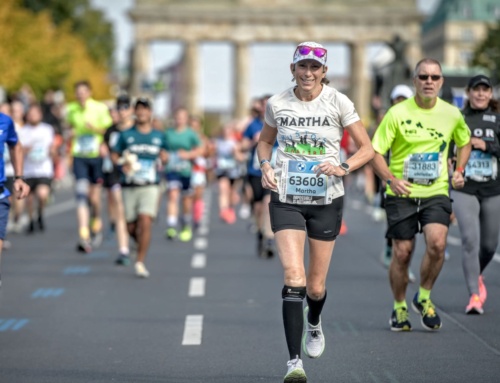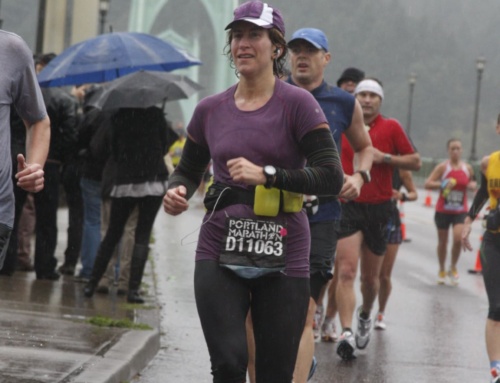How I Trained for My First Marathon

BAMR PAMR’s race day is (almost) around the corner (February 10!)—and she received some special encouragement in the mail from a fellow BAMR! (So cute!)
[Race day is almost here! Read BAMR PAMR’s marathon training journey.]
Last Sunday, the morning of my non-negotiable 20-mile run, I woke up nearly paralyzed by fear. Unlike my previous collision with imposter syndrome, this fear had a solid grounding in reality. Up until the week of Christmas, my training had progressed in an entirely unremarkable fashion. The training plan detailed a workout; I executed that workout as written. I set my alarm earlier and earlier on weekdays to accommodate six, and then seven, and then eight easy miles, and still get home in time to help get all four of us to work and daycare on time. I killed an 18-miler.
And then it—or shin splits—happened.
Midway through my second 18-miler, I felt the beginnings on a niggle along my lower right leg. I tried not to panic as I checked and rechecked my form, taking rare walk breaks until things downstairs calmed down. I managed to complete the run, fast finish miles and all, but I had a sinking feeling in my gut that the niggle wasn’t done with me. I took two rest days rather than the usual one, but on Wednesday, I had to cut my seven miles down to six. The warmup felt great, the race pace miles could not have felt better, but as soon as I slowed into my cooldown, the inner bits of my lower right leg started burning. I trudged home feeling a mixture of panic and defeat.
When I had a few free moments that morning, I called my big sister Katie, who also happens to be the best PT I know. She encouraged me to look for horses rather than zebras and focus on the obvious culprit: shoes. Katie instructed me to trade in my minimalist Altra Solstice and Topo Magnafly running shoes for some styles with more padding to absorb the greater stress of marathon training, and add some compression calf sleeves to my wardrobe.

New kicks and new sleeves!
In addition to purchasing new shoes and accessories, I doubled down on strength, mobility, and recovery. Coach Amanda’s training plans include “pre-hab” exercises like single-leg deadlifts and hip hikes, and I focused on performing these moves daily. I also foam-rolled at least once a day, often more, from my calves and shins all the way up to my neck. I spent some quality time with a lacrosse ball, focusing largely on my feet, calves, and glutes. I stretched my calves, hips, and everything else a couple times a day. When I was able to run, I iced my lower legs after.
I got fit for some Brooks Ricochet and Brooks Launch shoes at my local Fleet Feet, and eased back into running, taking each day and each mile as it came. Some days the shin splints crept in early in the run, some days a bit later. As soon as things felt tight or sore or just not quite right, I’d slow to a walk for a bit. Often walking would calm things down, and then I could run for a bit. I felt a bit stronger each day, and set out for a planned 18-20 mile long run on January 6, knowing I might have to cut it a bit short. I ran the first 11 miles without incident, and then had to stop regularly for walk breaks. By the time I hit 16 miles, the walk breaks weren’t helping as much, so I walked home to get one more mile on my feet.
I didn’t feel any niggles the day after my 16-miler, so I ran eight miles a few days later. While the run itself felt good, my shins felt distinctly not good the rest of the day. At that point, I was ready to throw in the towel, mentally and physically.

Hanging on MARTA with two of the cutest passengers ever.
So you know what I did? I quit. That’s right. Straight up quit running. I relegated all of my running apps, including social media as that’s pretty much its only purpose in my life these days, to the third screen on my phone. I stashed my running shoes and clothes and journal out of sight. I read Patriot Games, a 1980’s espionage thriller where the only running consists of Jack Ryan throwing himself headlong into danger. I listened to Wooden Overcoats, the only non-running podcast in my queue. I spent Sunday escorting my 4-year-old and her class bear, Cupcake, around town. I drank beer and ate an embarrassing amount of leftover peppermint M&M candies.
Friends, it was glorious. It was exactly what I needed. One week after I quit, I laced up my Brooks Ricochets, took some deep breaths, reminded myself that no one run defines my worth as a runner or as a human being, and took once more to the streets. I ran a little over three miles and quit before anything started to hurt. I still felt good two days later, so I ran four, most of them around and around the muddy crushed gravel Active Oval at Piedmont Park. Once again, things still felt good downstairs—but upstairs was another story.
Which takes us to Sunday, day of the non-negotiable 20-miler. I approached the run like a preschooler approaches bedtime: I dawdled. I took all the time in the world to eat an English muffin with peanut butter, to get dressed, to stretch out my calves and my hips and my glutes, to roll out those same areas, to get my podcast queue just right, to choose and organize my fuel. And so on, ad infinitum. Finally the moment arrived. I had done everything I possibly could to delay the run. I kissed my daughters and my husband, and I stepped out into the cold.
Because I was unsure of what to expect out of the run, and because I wanted the security blanket of being close to home the entire time, I chose to run a flat—679 ft. total gain rather than the 1500 ft. plus of my usual out-and-back—and boring five-mile loop four times. The first loop felt great. I ducked into the neighborhood coffee shop to pee and hit the road for the second loop. By the end of mile 8, I started to feel my right lower leg getting a little tight. I slowed to a walk, feeling more than a little angry and discouraged. After a minute or so of walking, I picked up the pace to a run. Another half mile and my leg told me to walk.

All smiles after 20 miles!
I wanted to quit again. But more than that, I wanted to see what I was capable of. I decided to use this final LONG run of the training cycle to figure out a blueprint of the Penultimate Case Scenario. Not the Worst Case Scenario—that would be a DNS or a DNF. No, this would be the second-to-worst. If I felt some warning niggles on race day, how would I handle it? Not the kind of sharp, race-ending, season-ending pain that indicates an acute injury that sends a runner to her knees, but a niggle that indicates the runner is not going to have the race she wanted. Could I handle that scenario with grace and with bravery-cum-grit? Now was the perfect opportunity to find out.
So I pulled up my entirely metaphoric big girl panties (#commando4life!) and took some deep calming breaths: inhale for four, hold for four, exhale for four, hold for four. I adjusted my attitude and focused on forward movement. I made it my goal to run until I hit X.0 or X.5 on my watch, giving myself the leeway to run longer if everything felt good downstairs or shorter if it did not. I didn’t look at my pace, and I didn’t look at my heartrate. I ran what felt sustainable. Work, Play, Love segued into Another Mother Runner. The miles passed in half-ish mile increments. Halfway through Neely Gracey’s pregnancy and ¾ of the way through my run, my headphone batteries gave up the ghost—in all that dawdling, I’d neglected to charge my trusty Trekz Airs. Oops. To be honest, though, I was so focused on my new goal of creating a Penultimate Case Scenario blueprint that I didn’t even miss the dulcet tones of SBS and Coach Amanda in my ears.
I finished that 20-miler, friends. I finished with a big, goofy grin on my face, and at a pretty usual overall pace of 11:57. I finished knowing that I can handle things going sideways mid-race with grace and bravery and grit. I finished with a confidence I haven’t felt in weeks.






It really, truly stinks that the shins splints continue to plague you, though I love your mindset for your non-negotiable 20: see what you’re made of and how to handle the not-quite-worst-case scenario. Enjoy that marathon for what it will be: your first, your P.R! Love you, BAMR Pamr❤️
Way to go, BAMR PAMR! Can’t wait to read your race report. Go get it!
You must be so very proud of yourself for negotiating this pitstop along the way! We are proud of you too and are pulling for you long the way! Thanks for being so ordinary and also so great. XO
I totally got chills reading this! I know you are proud of yourself for getting past that big mental hurdle! Can’t wait to read about the big event!
Yay, that feeling of finishing a 20-miler is complete empowerment!
Taper advice: wash your hands, wash your hands, and oh, wash your hands! Kids are adorable Petrie dishes and you don’t want to get sick. Enjoy your celebration and automatic PR!
What an awesome, inspiring story! I was laughing out loud reading about the week you “quit.” While I am not training for my first marathon, I am training for my second in 15 years! I am only up to 8 miles as my long run but can completely relate to the mind games we have to play and the physical resources we have to tap into. Enjoy your taper and best of luck to you in the race!
I am cheering for you! This post got me to submit my guaranteed entry for NYC. Thanks for the nudge!
So excited for you. I remember the incredible feeling I had after finishing my first 20 miler. It’s amazing. You’re amazing. Enjoy the taper. That 26.2 victory lap is right around the corner!
I’m cheering for you Pam! It all sounds familiar to me – the physical niggles, self-doubt, the temporary break in training (and thinking about training)…I think it’s all part of the process. The hay is officially in the barn. You’ve done the work and have a great mental game as well – go get it!
P.S: And as Lisa Dennis said above “Wash Your Hands!” And carry hand sanitizer everywhere.
Well done! You are an inspiration and I have enjoyed your journey so far; can’t wait for you to cross that finish line!
Good job Pam!!! That is a 20 miler that you can be super proud of and you will draw upon often!
I’ve enjoyed ready your stories – I am training for my first also. You have made the whole process seem more real and have given me inspiration to keep going even when things are not how you want them to be. Cannot wait to read about the rest of your journey!!
Way to go Pam! Excellent relatable well written recap! Let me just say, “The mind is a liar too!” There is such a thing of ‘phantom pains’. Don’t let it talk to you. One thing I’ll never forget I heard from an ultra runner podcast is “most pains don’t last”. I really hung on to that and I can say she was right. I ran. 33 mile race in September and I now know what she meant. The pains do move around though . I did get shin splints after my first marathon and they were the most painful thing I’ve ever experienced! I couldn’t run or walk on a treadmill even for weeks! Sounds like you are doing all of the right things though so you’ll be good. Maybe try a run/walk/run too. My best marathon time was the one I did that ♀️ Who would have thought.
I just can’t wait to hear more! Congratulations on that 20 miler. You’ve don’t a great job at working with things you can control and have such a great attitude!!!
Thank you all for your kind comments, love, and support! <3
Go, Pam, Go!!! Shin splints royally suck! I’m cheering for you from balmy ND!!!!
So nice to read your story, Pam. For my first marathon, on my 20 miler, I literally tripped over a 1/2″ diameter stone. I didn’t step on it, but seriously tripped over it, going down HARD on both knees. This was about 20ft before the turn around point of the out and back. I could see my coach up ahead at the turn, on his bike. So, there was no way home other than turning around and running back 10 miles with bruised bloody knees. So, I turned, rinsed off my knees with my water bottle, and starting walking, then eventually starting running with people on the trail pointing out that my legs were bleeding. I finished my 20 miler and it was the Baddest A$$ thing I had ever done (outside of giving birth). Throughout my very miserable marathon, I kept going back to myself finishing that 20 miler and knew deep down that no matter my misery, I WOULD finish. Take that feeling with you! You earned it. Enjoy the Taper! <3
Remember — the hay is in the barn! You have proven you can do hard things, so now you just need to stay healthy and ignore all those taper twinges to hit the starting line with a smile, knowing you are ready for whatever comes that day!